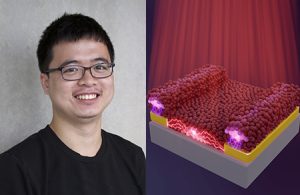ENS – Salle de conférences IV, 24 rue Lhomond, Paris
 Light manipulation for enhanced photodetection performance and novel functionalities in colloidal nanocrystal-based infrared sensors
Light manipulation for enhanced photodetection performance and novel functionalities in colloidal nanocrystal-based infrared sensors
Abstract
This thesis focuses on the use of optical nanostructures in nanocrystal-based infrared photodetectors. Integrating optical structures into photodetectors has been demonstrated to improve the devices’ speed and sensitivity. In the case of nanocrystal-based photodetectors, using optical resonators is particularly beneficial. Indeed, because of the hopping mechanism, carrier diffusion lengths in a nanocrystal array are several times shorter than the material’s absorption depth. This limited transport leads to a trade-off for the thickness of nanocrystal films between optical absorption and charge collection efficiency in photodetectors. Optical nanostructures enable the manipulation of light at subwavelength scales. They can thus be exploited to focus light on ultrathin nanocrystal films compatible with carrier transport. In addition to the enhanced performance of the sensing devices, we also show that advanced functionalities can be generated by coupling nanocrystals with optical structures. Such functionalities result from the bias-reconfigurable photoresponse of the devices. We show that hopping transport, often seen as a limitation for optoelectronic devices, is a crucial ingredient for bias reconfigurability and the design of active photoconductive nanocrystal devices. Lastly, a combination of a photodiode structure and plasmonic resonators will be presented. The obtained device is among the most sensitive and fastest mid-wave infrared photodetectors reported so far based on colloidal nanocrystals operating at cryogenic temperature. Furthermore, we demonstrate that combining our plasmonic structures with a single diode stack can generate a multicolor bias reconfigurable response and introduce new functionalities such as band rejection and current bi-directionality.
Jury
- M. Jean-Pierre HERMIER (GEMaC – UVSQ) – Rapporteur
- M. Riad HAIDAR (ONERA – École Polytechnique) – Rapporteur
- Mme. Agnès MAÎTRE (INSP – Sorbonne Université) – Examinatrice
- M. Roman KRAHNE (Italian Institute of Technology) – Examinateur
- M. Jean-Christophe LACROIX (Université Paris Cité) – Examinateur
- Mme. Angela VASANELLI (LPENS – Université Paris Cité) – Directrice de thèse
- M. Emmanuel LHUILLIER (INSP – Sorbonne Université) – Co-directeur de thèse

